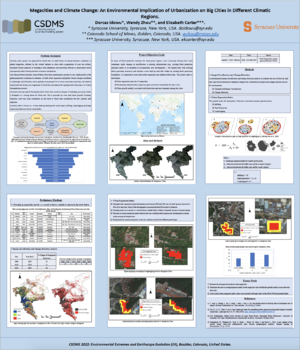2022 CSDMS meeting-063: Difference between revisions
From CSDMS
(Created page with "{{CSDMS meeting personal information template-2022 |CSDMS meeting first name=Dorcas |CSDMS meeting last name=Idowu |CSDMS meeting institute=Syracuse University |CSDMS meeting...") |
No edit summary |
||
| (8 intermediate revisions by 2 users not shown) | |||
| Line 22: | Line 22: | ||
}} | }} | ||
{{CSDMS meeting abstract title temp2022 | {{CSDMS meeting abstract title temp2022 | ||
|CSDMS meeting abstract title=Megacities and Climate Change: | |CSDMS meeting abstract title=Megacities and Climate Change: An environmental implication of Urbanization on Ten Megacities in different climatic regions. | ||
|Working_group_member_WG_FRG=Terrestrial Working Group, Coastal Working Group, Hydrology Focus Research Group | |Working_group_member_WG_FRG=Terrestrial Working Group, Coastal Working Group, Hydrology Focus Research Group | ||
}} | |||
{{CSDMS meeting authors template | |||
|CSDMS meeting coauthor first name abstract=Wendy | |||
|CSDMS meeting coauthor last name abstract=Zhou | |||
|CSDMS meeting coauthor institute / Organization=Colorado School of Mines | |||
|CSDMS meeting coauthor town-city=Golden | |||
|CSDMS meeting coauthor country=United States | |||
|State=Colorado | |||
|CSDMS meeting coauthor email address=wzhou@mines.edu | |||
}} | |||
{{CSDMS meeting authors template | |||
|CSDMS meeting coauthor first name abstract=Elizabeth | |||
|CSDMS meeting coauthor last name abstract=Carter | |||
|CSDMS meeting coauthor institute / Organization=Syracuse University | |||
|CSDMS meeting coauthor town-city=Syracuse | |||
|CSDMS meeting coauthor country=United States | |||
|State=New York | |||
|CSDMS meeting coauthor email address=ekcarter@syr.edu | |||
}} | }} | ||
{{CSDMS meeting abstract template 2022 | {{CSDMS meeting abstract template 2022 | ||
|CSDMS meeting abstract= | |CSDMS meeting abstract=Globally, more people are impacted by floods than all other forms of natural disasters combined. In global megacities, defined by the United Nations as cities with a population of over ten million, increased human exposure to flooding is both ubiquitous and extremely difficult to characterize. Over the past three decades, most of these cities have experienced a gradual or very rapid growth as the global population continues to urbanize. As both urban expansion and global climate change contribute to hydrologic intensification, and as globally more people live in urban areas than rural ones, the need to assess both the drivers and magnitude of flood risk associated with rapid growth in megacities is of critical humanitarian concern. Through a multitemporal analysis (2000, 2010, and 2020) of urban growth modes and urban landscape change detection using the Landsat dataset (ETM+, OLI), we estimate the growth rates and development patterns in ten global megacities (Guangzhou, Tokyo, Lagos, Jakarta, Delhi, Manila, Mumbai, Seoul, Mexico City, New York) representing different global climate zones using machine learning. Trends in runoff magnitudes over the time period are quantified and associated with urban expansion and non-stationarity in regional historical precipitation patterns. Preliminary results showed that the ten cities have experienced major flooding within the last ten years resulting mostly as a result of heavy rainfall. | ||
|CSDMS meeting posterPDF= IDOWUCSDMSPOSTER.pdf | |||
|CSDMS meeting posterPNG=IDOWUCSDMSPOSTER.png | |||
}} | }} | ||
{{blank line template}} | {{blank line template}} | ||
Latest revision as of 15:26, 16 May 2022
(if you haven't already)
Log in (or create account for non-CSDMS members)
Forgot username? Search or email:CSDMSweb@colorado.edu
Browse abstracts
Megacities and Climate Change: An environmental implication of Urbanization on Ten Megacities in different climatic regions.
Dorcas Idowu,
Syracuse University Syracuse New York, United States. doidowu@syr.edu
Wendy Zhou, Colorado School of Mines Golden Colorado, United States. wzhou@mines.edu
Elizabeth Carter, Syracuse University Syracuse New York, United States. ekcarter@syr.edu
Globally, more people are impacted by floods than all other forms of natural disasters combined. In global megacities, defined by the United Nations as cities with a population of over ten million, increased human exposure to flooding is both ubiquitous and extremely difficult to characterize. Over the past three decades, most of these cities have experienced a gradual or very rapid growth as the global population continues to urbanize. As both urban expansion and global climate change contribute to hydrologic intensification, and as globally more people live in urban areas than rural ones, the need to assess both the drivers and magnitude of flood risk associated with rapid growth in megacities is of critical humanitarian concern. Through a multitemporal analysis (2000, 2010, and 2020) of urban growth modes and urban landscape change detection using the Landsat dataset (ETM+, OLI), we estimate the growth rates and development patterns in ten global megacities (Guangzhou, Tokyo, Lagos, Jakarta, Delhi, Manila, Mumbai, Seoul, Mexico City, New York) representing different global climate zones using machine learning. Trends in runoff magnitudes over the time period are quantified and associated with urban expansion and non-stationarity in regional historical precipitation patterns. Preliminary results showed that the ten cities have experienced major flooding within the last ten years resulting mostly as a result of heavy rainfall.

